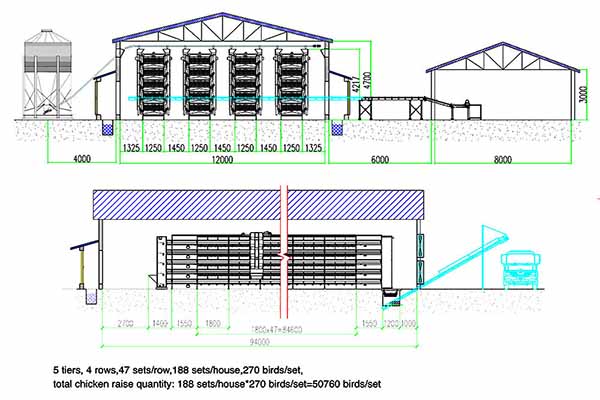Poultry Farming Cage Systems: A Comprehensive Guide in Uganda
Time : 2025-06-27
Uganda, a country located in East Africa, has been witnessing an increasing demand for poultry products due to its growing population and rising urbanization. As a result, poultry farming has become a key industry in the country. This article focuses on poultry farming cage systems in Uganda, providing an in-depth analysis of the various cage systems available, their benefits, and the latest trends in this field.
Introduction to Poultry Farming in Uganda
Poultry farming has been a traditional industry in Uganda, but it has evolved significantly over the years. Today, modern poultry farming practices have become popular, with various cage systems being utilized to improve productivity and ensure the well-being of the birds.
Types of Poultry Farming Cage Systems
1. Barn-Style Cage Systems
Barn-style cage systems are commonly used in large-scale poultry farms in Uganda. These systems provide space for chickens to move around, eat, and sleep, while preventing them from wandering away. The cages are made of metal and can be adjusted to fit different breeds and age groups.
2. Deep-Litter Systems
Deep-litter systems are another popular choice among poultry farmers in Uganda. These systems involve spreading a deep layer of bedding material, such as wood shavings, on the floor of the poultry house. The chickens are allowed to roam freely within the house, which can lead to better health and productivity.
3. Battery Cage Systems
Battery cage systems are designed for egg production and are commonly used in commercial poultry farms in Uganda. The chickens are confined to small, individual cages with enough space for them to stand up and turn around but not to move freely. This system minimizes the risk of disease spread and provides a consistent egg supply.
4. Free-Range Systems
Free-range systems allow chickens to roam freely in a larger area, which can enhance their overall well-being. These systems are gaining popularity in Uganda, particularly among small-scale poultry farmers. However, they require more space and resources to manage, making them less feasible for large-scale commercial operations.
Benefits of Poultry Farming Cage Systems
1. Improved Productivity
Cage systems provide an optimal environment for chickens to thrive, resulting in higher productivity. Proper ventilation, lighting, and temperature control in the poultry house ensure that the birds remain healthy and lay eggs at a consistent rate.
2. Cost-Effective
Using cage systems can be cost-effective for poultry farmers in Uganda. By minimizing the risk of disease spread and improving productivity, farmers can reduce feed costs and increase profits.
3. Easier Management
Cage systems make it easier for farmers to manage their poultry flocks. The confined spaces allow for easier observation of the birds, making it easier to identify and treat any health issues.
4. Animal Welfare
Cage systems can promote animal welfare, as they provide adequate space for chickens to move and express their natural behaviors. Additionally, the use of cage systems can minimize the risk of accidents and injuries to the birds.
Trends in Poultry Farming Cage Systems in Uganda
1. Increased Focus on Animal Welfare
Ugandan poultry farmers are increasingly focusing on animal welfare, with many adopting cage systems that provide more space and natural light. This shift is driven by both consumer demand and the ethical considerations of the farming community.
2. Technological Advancements
Advancements in technology have made it possible to create more efficient and cost-effective poultry farming cage systems. Modern systems come with features like automated feeding and waste management, which can improve the overall productivity of poultry farms.
3. Sustainability Initiatives
Sustainability initiatives are becoming increasingly important in the poultry industry, with farmers looking for ways to minimize their environmental impact. This includes using renewable energy sources and adopting waste management practices that reduce pollution.
Conclusion
Poultry farming cage systems play a crucial role in the poultry industry in Uganda. By improving productivity, reducing costs, and promoting animal welfare, these systems have become an integral part of modern poultry farming practices. As the industry continues to grow, it is essential for poultry farmers to stay informed about the latest trends and advancements in cage systems to ensure the success of their businesses.












